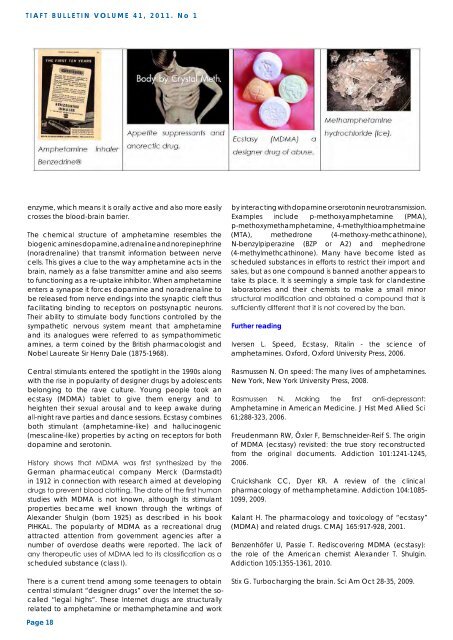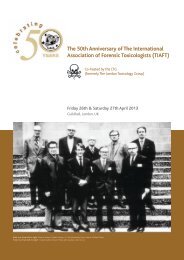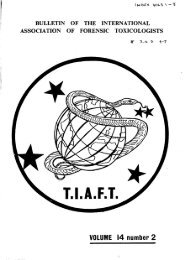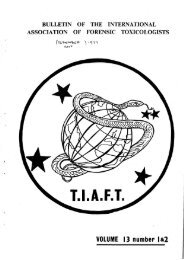Volume XLI Number 1.pdf - The International Association of Forensic ...
Volume XLI Number 1.pdf - The International Association of Forensic ...
Volume XLI Number 1.pdf - The International Association of Forensic ...
Create successful ePaper yourself
Turn your PDF publications into a flip-book with our unique Google optimized e-Paper software.
TIAFT BULLETIN VOLUME 41, 2011. No 1<br />
enzyme, which means it is orally active and also more easily<br />
crosses the blood-brain barrier.<br />
<strong>The</strong> chemical structure <strong>of</strong> amphetamine resembles the<br />
biogenic amines dopamine, adrenaline and norepinephrine<br />
(noradrenaline) that transmit information between nerve<br />
cells. This gives a clue to the way amphetamine acts in the<br />
brain, namely as a false transmitter amine and also seems<br />
to functioning as a re-uptake inhibitor. When amphetamine<br />
enters a synapse it forces dopamine and noradrenaline to<br />
be released from nerve endings into the synaptic cleft thus<br />
facilitating binding to receptors on postsynaptic neurons.<br />
<strong>The</strong>ir ability to stimulate body functions controlled by the<br />
sympathetic nervous system meant that amphetamine<br />
and its analogues were referred to as sympathomimetic<br />
amines, a term coined by the British pharmacologist and<br />
Nobel Laureate Sir Henry Dale (1875-1968).<br />
Central stimulants entered the spotlight in the 1990s along<br />
with the rise in popularity <strong>of</strong> designer drugs by adolescents<br />
belonging to the rave culture. Young people took an<br />
ecstasy (MDMA) tablet to give them energy and to<br />
heighten their sexual arousal and to keep awake during<br />
all-night rave parties and dance sessions. Ecstasy combines<br />
both stimulant (amphetamine-like) and hallucinogenic<br />
(mescaline-like) properties by acting on receptors for both<br />
dopamine and serotonin.<br />
History shows that MDMA was first synthesized by the<br />
German pharmaceutical company Merck (Darmstadt)<br />
in 1912 in connection with research aimed at developing<br />
drugs to prevent blood clotting. <strong>The</strong> date <strong>of</strong> the first human<br />
studies with MDMA is not known, although its stimulant<br />
properties became well known through the writings <strong>of</strong><br />
Alexander Shulgin (born 1925) as described in his book<br />
PIHKAL. <strong>The</strong> popularity <strong>of</strong> MDMA as a recreational drug<br />
attracted attention from government agencies after a<br />
number <strong>of</strong> overdose deaths were reported. <strong>The</strong> lack <strong>of</strong><br />
any therapeutic uses <strong>of</strong> MDMA led to its classification as a<br />
scheduled substance (class I).<br />
<strong>The</strong>re is a current trend among some teenagers to obtain<br />
central stimulant “designer drugs” over the Internet the socalled<br />
“legal highs”. <strong>The</strong>se Internet drugs are structurally<br />
related to amphetamine or methamphetamine and work<br />
Page 18<br />
by interacting with dopamine or serotonin neurotransmission.<br />
Examples include p-methoxyamphetamine (PMA),<br />
p-methoxymethamphetamine, 4-methylthioamphetmaine<br />
(MTA), methedrone (4-methoxy-methcathinone),<br />
N-benzylpiperazine (BZP or A2) and mephedrone<br />
(4-methylmethcathinone). Many have become listed as<br />
scheduled substances in efforts to restrict their import and<br />
sales, but as one compound is banned another appears to<br />
take its place. It is seemingly a simple task for clandestine<br />
laboratories and their chemists to make a small minor<br />
structural modification and obtained a compound that is<br />
sufficiently different that it is not covered by the ban.<br />
Further reading<br />
Iversen L. Speed, Ecstasy, Ritalin - the science <strong>of</strong><br />
amphetamines. Oxford, Oxford University Press, 2006.<br />
Rasmussen N. On speed: <strong>The</strong> many lives <strong>of</strong> amphetamines.<br />
New York, New York University Press, 2008.<br />
Rasmussen N. Making the first anti-depressant:<br />
Amphetamine in American Medicine. J Hist Med Allied Sci<br />
61;288-323, 2006.<br />
Freudenmann RW, Öxler F, Bernschneider-Reif S. <strong>The</strong> origin<br />
<strong>of</strong> MDMA (ecstasy) revisited: the true story reconstructed<br />
from the original documents. Addiction 101:1241-1245,<br />
2006.<br />
Cruickshank CC, Dyer KR. A review <strong>of</strong> the clinical<br />
pharmacology <strong>of</strong> methamphetamine. Addiction 104:1085-<br />
1099, 2009.<br />
Kalant H. <strong>The</strong> pharmacology and toxicology <strong>of</strong> “ecstasy”<br />
(MDMA) and related drugs. CMAJ 165:917-928, 2001.<br />
Benzenhöfer U, Passie T. Rediscovering MDMA (ecstasy):<br />
the role <strong>of</strong> the American chemist Alexander T. Shulgin.<br />
Addiction 105:1355-1361, 2010.<br />
Stix G. Turbocharging the brain. Sci Am Oct 28-35, 2009.







